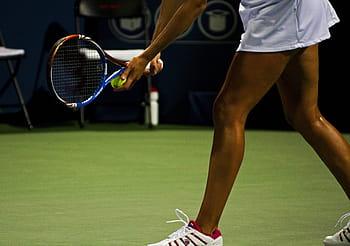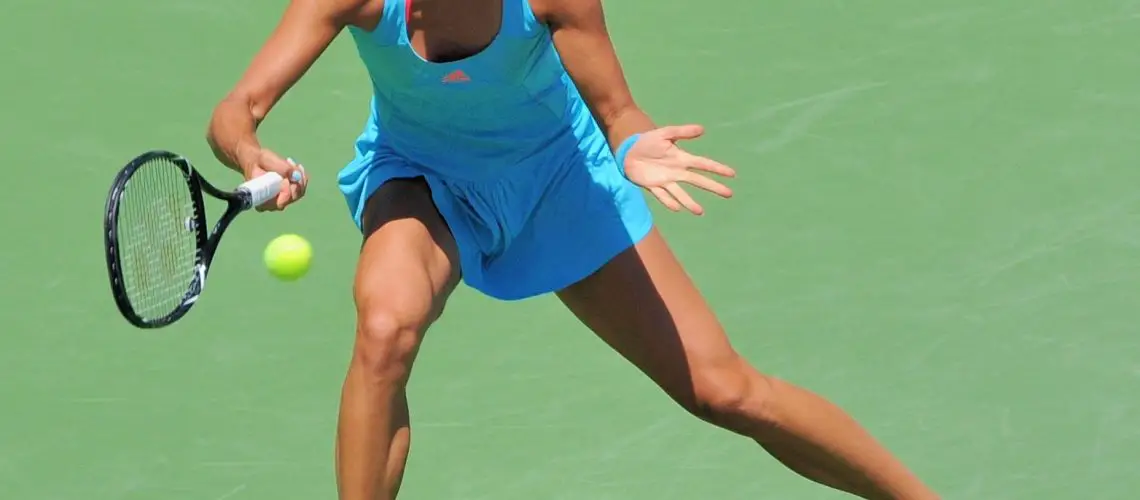We may earn money or products from the companies mentioned in this post.
A Quick Summary

Tennis players must master the proper grip technique to optimize performance and reduce injury risk. There are three main types of grips: Eastern, Western, and Continental. To improve grip technique, practice switching between grips, incorporate drills, and experiment with varying stroke techniques. Additionally, maintain proper wrist positioning, use online tutorials, and seek professional coaching. This will help increase accuracy, power, and consistency.
The Importance of Proper Grip in Tennis
When it comes to tennis, having the right grip on your racket can make all the difference Not only does it enhance your performance and control on the court, but it also reduces the risk of injury
Enhances Performance and Control
A proper grip allows for better maneuverability of the racket and greater control over shots It enables players to hit with more power and accuracy, making their game more effective overall With a correct grip, players can easily adjust their strokes based on varying situations during matches
Reduces the Risk of Injury
Poor grip technique can lead to injuries such as wrist strain or tendinitis A faulty grip can also cause unnecessary tension in the arm muscles, leading to fatigue or even long-term damage By using a proper grip technique, players can reduce the likelihood of these injuries while optimizing their performance
Common Mistakes Players Make with Racket Grips

Despite its importance, many players still struggle with finding and maintaining a correct grip on their racket Here are some common mistakes that players make:
Gripping too tightly:
This causes unnecessary tension in the arm muscles and restricts movement
Gripping too loosely:
This leads to less control over shots and increases the risk of losing hold of the racket during play
Misaligned hand placement:
Placing hands too high or low on the handle can affect shot accuracy and power
Inconsistent grips:
Not maintaining a consistent grip throughout play results in inconsistent shots
To avoid these mistakes, it’s important to work with a coach or experienced player to learn and practice proper grip technique With the right grip, players can take their game to the next level while minimizing the risk of injury
| Common Mistake | Consequence | Solution |
|---|---|---|
| Gripping too tightly | Unnecessary tension, restricted movement | Work on a relaxed grip with a coach or experienced player |
| Gripping too loosely | Less control, risk of losing hold of racket during play | Practice proper grip technique to find the optimal grip strength |
| Misaligned hand placement | Affects shot accuracy and power | Learn correct hand placement on handle from coach or experienced player |
Different Types of Tennis Grips

Tennis is a game that requires skill, technique, and precision One of the key elements to master in order to play tennis well is the grip There are several different types of tennis grips, each with its own advantages and disadvantages In this article, we’ll explore the three most common types: Eastern grip, Western grip, and Continental grip (also known as Chopper Grip).
Eastern Grip
The Eastern grip is one of the oldest and most popular types of tennis grips It’s characterized by a semi-western position with the base knuckle of your index finger on the third bevel (or flat surface) of your racquet handle To hold an Eastern grip, start by placing your palm on the racquet handle with your fingers spread wide apart Make sure that your thumb is resting against the side of the racquet handle
One advantage of using an Eastern grip is that it allows for greater control over flat shots and serves This type of grip also provides more stability when hitting groundstrokes due to its neutral position on the racquet handle However, one disadvantage is that it can be difficult to generate topspin on forehand shots
Western Grip
The Western grip is a more modern type of tennis grip commonly used by players who prefer to hit with topspin To hold a Western grip, place your palm on top of the racquet handle so that your base knuckle rests between bevels four and five (closer to five). Your index finger should be slightly separated from the other fingers
One advantage of using a Western grip is that it allows for greater spin generation due to its extreme angle on the racquet handle This type of grip also provides more power when hitting groundstrokes because it promotes an upward swing path through contact with the ball However, one disadvantage is that it can be difficult to control the direction of your shots with this grip
Continental Grip
The Continental grip is a versatile type of tennis grip that can be used for a variety of different shots To hold a Continental grip, place your palm on the bottom edge of the racquet handle with your index finger angled towards the right side of the racquet Your thumb should be resting against the left side of the racquet handle
One advantage of using a Continental grip is that it allows for greater flexibility when hitting different types of shots, including serves, volleys, and even slice backhands This type of grip also provides more feel and touch when hitting drop shots or delicate shots around the net However, one disadvantage is that it can be difficult to generate power on groundstrokes due to its position on the racquet handle
In conclusion, mastering different types of tennis grips is essential for any player who wants to excel at this sport Each type has its own advantages and disadvantages, and choosing one over another depends on factors such as personal preference, playing style, and court surface By experimenting with different types of grips and practicing consistently, you’ll be able to find the perfect fit for your game
| Grip Type | Advantage | Disadvantage |
|---|---|---|
| Eastern Grip | Greater control over flat shots and serves | Difficulty generating topspin on forehands |
| Western Grip | Greater spin generation and power on groundstrokes | Difficulty controlling shot direction |
| Continental Grip | Versatility for different types of shots | Difficulty generating power on groundstrokes |
Step-by-Step Guide on How to Hold a Tennis Racket Properly

Choose Your Preferred Type of Tennis Racket
Choosing the right tennis racket is crucial in achieving optimal performance on the court There are several factors to consider when selecting your preferred type of tennis racket, including size, weight, and balance The size of the racket’s head should be proportionate to your skill level and playing style A larger head provides more power, but it can also be challenging to control for beginners
The weight of the racket is another essential factor to consider Lighter rackets are easier to handle but may not provide enough power for advanced players Meanwhile, heavier rackets offer more power but require more effort to maneuver
Lastly, the balance of the racket affects how it feels in your hand during play Head-heavy rackets provide more power, while head-light rackets offer better control and maneuverability
Hold Your Racket Handle Correctly
Once you have selected your preferred tennis racket, it’s time to learn how to hold it correctly Start by using your dominant hand to grip the handle firmly but not too tightly Find a comfortable position for your fingers that allows you to grip without straining them
The pressure you apply while holding the racket is also crucial in maintaining control over it during play Too much pressure can cause tension in your arm and affect your swing’s accuracy and speed
Adjusting Your Non-Dominant Hand
Your non-dominant hand plays a supporting role in two-handed backhand strokes and helps switch between forehand and backhand grips smoothly When hitting a two-handed backhand shot, place your non-dominant hand above or below your dominant hand on the handle Adjust your grip accordingly when switching between forehand and backhand shots
By following these steps, you can hold your tennis racket properly and improve your game on the court Remember to choose the right type of racket for your skill level and playing style, grip it firmly but not too tightly with your dominant hand, and adjust your non-dominant hand as needed for optimal control during play
| Key Points | Description |
|---|---|
| Choose the right racket | Select a racket suitable for your skill level and playing style |
| Firm but not tight grip | Grip the handle firmly with your dominant hand, without applying too much pressure |
| Adjust non-dominant hand | Use your non-dominant hand to support two-handed backhand strokes and switch between grips smoothly |
Tips for Improving Your Tennis Racket Grip Technique

Practice Switching Between Different Grips During Play
One of the best ways to improve your tennis racket grip technique is to practice switching between different grips during play This will not only enhance your overall performance but also make you more versatile and adaptable on the court
Drills for Smooth Transitions:
Incorporate drills into your practice sessions that involve switching between different grips, such as forehand to backhand or volley to overhead These drills will help you develop muscle memory, making it easier for you to switch between grips smoothly in real game situations
Varying Stroke Techniques Based on Different Grips:
Experiment with varying stroke techniques based on the type of grip used For instance, a continental grip is often used for volleys and serves while an eastern forehand grip is commonly used for baseline shots
Maintain Proper Wrist Positioning Throughout Play
Another crucial aspect of improving your tennis racket grip technique is maintaining proper wrist positioning throughout play A relaxed yet firm wrist control can significantly improve your accuracy, power, and consistency on the court
Relaxed Yet Firm Wrist Control:
Your wrist should be relaxed but firm when holding the racket Avoid gripping too tightly or tensing up your muscles as this can hinder your flexibility and range of motion during play
Resources for Mastering the Art of Holding a Tennis Racket
If you want to master the art of holding a tennis racket, there are plenty of excellent resources available online and offline that can help you improve your skills
Online Tutorials and Videos:
You can find a wealth of information on the internet, including instructional videos, tutorials, and articles that provide useful tips and techniques for improving your tennis racket grip
Tennis Coaches and Trainers:
Consider hiring a professional tennis coach or trainer who can give you personalized feedback and guidance on improving your grip technique
By practicing switching between different grips, maintaining proper wrist positioning, and utilizing available resources, you can enhance your tennis racket grip technique and take your game to the next level
| Key Points | Description |
|---|---|
| Practice Switching Between Grips | Improves versatility and adaptability on the court; develop muscle memory for smooth transitions |
| Maintain Proper Wrist Positioning | Ensures accuracy, power, and consistency; focus on relaxed yet firm wrist control |
| Utilize Available Resources | Take advantage of online tutorials/videos and professional tennis coaches/trainers for personalized feedback |
Useful Links

How to Grip a Tennis Racket (with Pictures)
How to Swing a Tennis Racket for Beginners
The Definitive Guide on Tennis Grips
Tennis Tip: How To Find Your Racquet Grip Size
How To Hold A Tennis Racket Based On Feel
How to Regrip a Tennis Racket: 8-Step Grip Replacement …
HOW TO GRIP A TENNIS RACKET – spyn
How to Hold a Table Tennis Racket
How to Regrip a Tennis Racket – wikiHow Fitness
How to Hold a Tennis Racket Left-Handed: Tips for Lefties
Tennis Forehand Grip: Where To Place The Index Finger
How to Grip a Tennis Racket Properly for Beginners
How Tennis Racket Grip Sizes Are Measured
How to Hold Your Tennis Racket (4 Different Grips)
This is How You measure Your Tennis Grip Size
Four Steps to Determine Your Tennis Racket Grip Size
Tennis Grips | Different types of forehand grips explained
Tennis Forehand Grip Explained – All 4 Types [Used By Pros!]
Tennis 101: How to Grip a Forehand






